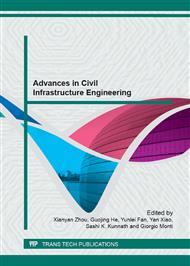p.644
p.648
p.652
p.657
p.665
p.670
p.678
p.682
p.688
Theoretical Analysis of Longitudinal Ventilation System in a Road Tunnel for Predictive Control Based on Inertia Effect
Abstract:
Speed control of longitudinal ventilation systems in road tunnels is being combined with typical model predictive control (MPC) strategies which may bring huge energy saving potential to the system. Theoretical analysis of the inertia effect is presented based on the energy equation of one dimensional incompressible unsteady flow, step response model is chosen to describe the dynamic behaviors of the system. The results show that the effect of jet speed change on CO concentration is nonlinear within fan’s economical working range and the settling time of CO level has similar change trend with that of the flow field but is a little longer. The system settling time is longer when jet speed decreases than it increases and is related to the change extent of jet speed. The effect of traffic intensity on CO concentration can be regarded as linear disturbance to the system output. These results may provide useful indexes to control the tunnel ventilation system more economically and lay foundation for the application of predictive control strategy in the system.
Info:
Periodical:
Pages:
665-669
Citation:
Online since:
January 2013
Authors:
Price:
Сopyright:
© 2013 Trans Tech Publications Ltd. All Rights Reserved
Share:
Citation:


